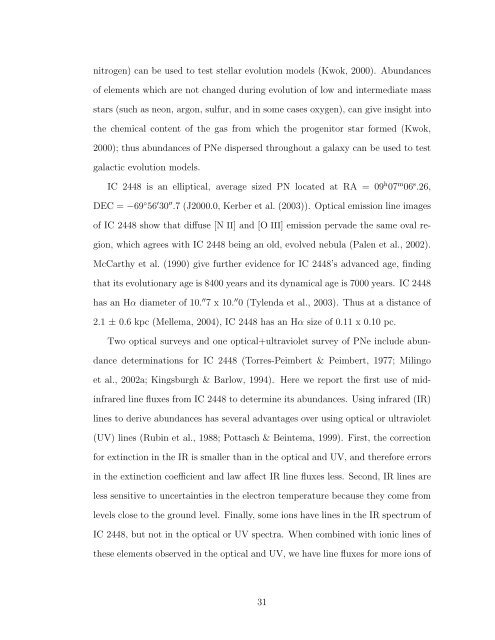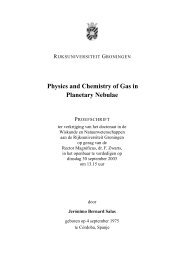TRACING ABUNDANCES IN GALAXIES WITH THE SPITZER ...
TRACING ABUNDANCES IN GALAXIES WITH THE SPITZER ...
TRACING ABUNDANCES IN GALAXIES WITH THE SPITZER ...
You also want an ePaper? Increase the reach of your titles
YUMPU automatically turns print PDFs into web optimized ePapers that Google loves.
nitrogen) can be used to test stellar evolution models (Kwok, 2000). Abundances<br />
of elements which are not changed during evolution of low and intermediate mass<br />
stars (such as neon, argon, sulfur, and in some cases oxygen), can give insight into<br />
the chemical content of the gas from which the progenitor star formed (Kwok,<br />
2000); thus abundances of PNe dispersed throughout a galaxy can be used to test<br />
galactic evolution models.<br />
IC 2448 is an elliptical, average sized PN located at RA = 09 h 07 m 06 s .26,<br />
DEC = −69 ◦ 56 ′ 30 ′′ .7 (J2000.0, Kerber et al. (2003)). Optical emission line images<br />
of IC 2448 show that diffuse [N II] and [O III] emission pervade the same oval re-<br />
gion, which agrees with IC 2448 being an old, evolved nebula (Palen et al., 2002).<br />
McCarthy et al. (1990) give further evidence for IC 2448’s advanced age, finding<br />
that its evolutionary age is 8400 years and its dynamical age is 7000 years. IC 2448<br />
has an Hα diameter of 10. ′′ 7 x 10. ′′ 0 (Tylenda et al., 2003). Thus at a distance of<br />
2.1 ± 0.6 kpc (Mellema, 2004), IC 2448 has an Hα size of 0.11 x 0.10 pc.<br />
Two optical surveys and one optical+ultraviolet survey of PNe include abun-<br />
dance determinations for IC 2448 (Torres-Peimbert & Peimbert, 1977; Milingo<br />
et al., 2002a; Kingsburgh & Barlow, 1994). Here we report the first use of mid-<br />
infrared line fluxes from IC 2448 to determine its abundances. Using infrared (IR)<br />
lines to derive abundances has several advantages over using optical or ultraviolet<br />
(UV) lines (Rubin et al., 1988; Pottasch & Beintema, 1999). First, the correction<br />
for extinction in the IR is smaller than in the optical and UV, and therefore errors<br />
in the extinction coefficient and law affect IR line fluxes less. Second, IR lines are<br />
less sensitive to uncertainties in the electron temperature because they come from<br />
levels close to the ground level. Finally, some ions have lines in the IR spectrum of<br />
IC 2448, but not in the optical or UV spectra. When combined with ionic lines of<br />
these elements observed in the optical and UV, we have line fluxes for more ions of<br />
31













